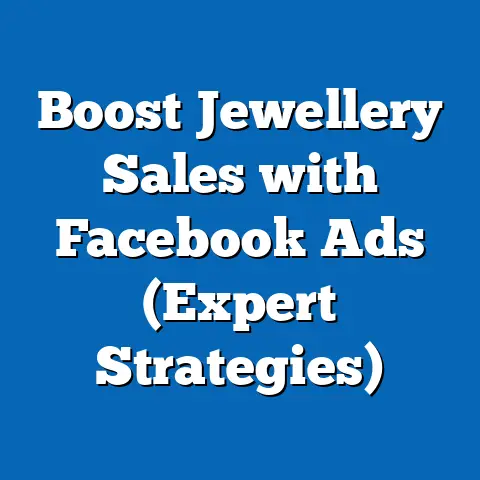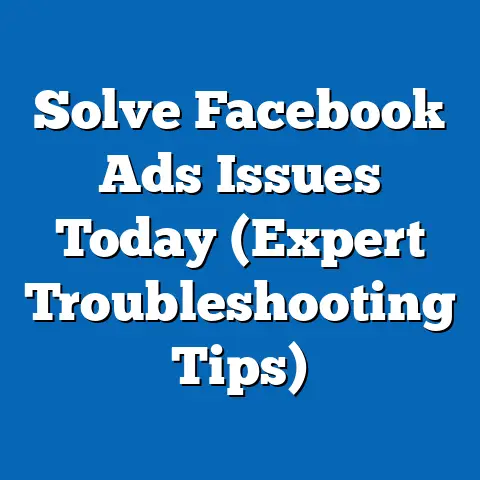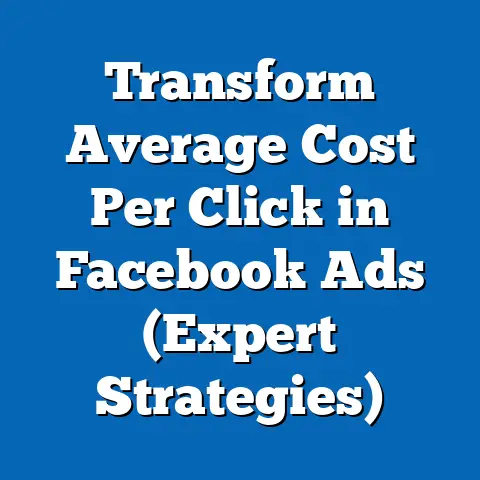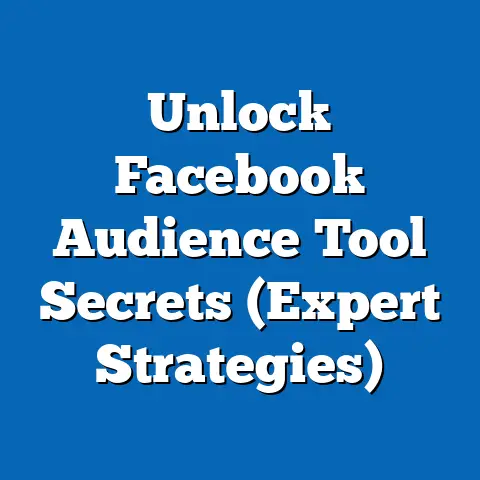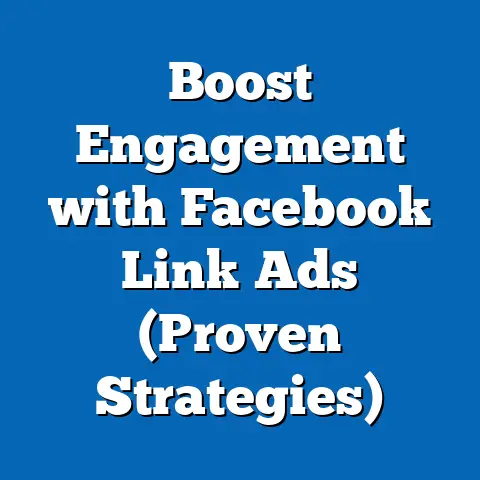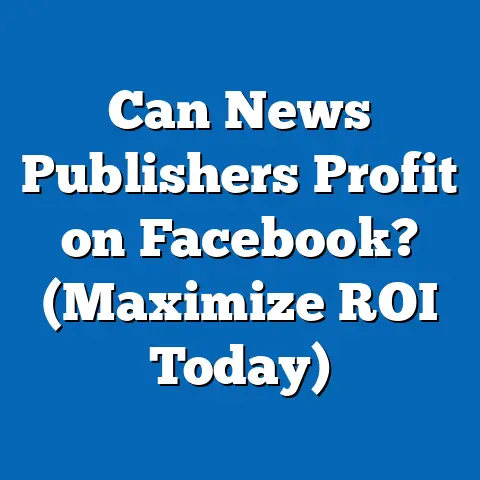Boost Chicago B2B with Targeted Facebook Ads (Pro Tips)
As a digital marketing specialist, I’ve seen firsthand how mastering Facebook advertising can be a game-changer for B2B companies, especially here in a dynamic market like Chicago. There’s a real craftsmanship involved – it’s not just about throwing money at ads and hoping for the best. It’s a blend of art and science, requiring a deep understanding of your target audience, a creative touch in ad design, and a strategic approach to campaign planning. Let’s dive into how you can transform your B2B marketing strategy in Chicago using the power of targeted Facebook ads.
Section 1: Understanding the Chicago B2B Landscape
Chicago’s B2B scene is a vibrant ecosystem, and understanding its unique characteristics is the first step to successful advertising. I’ve spent years navigating this market, and I can tell you, it’s unlike any other. We’re talking about a city that’s a hub for key industries like technology, manufacturing, and professional services.
- Technology: Chicago’s tech sector is booming, with startups and established companies alike driving innovation. Think software development, data analytics, and cloud computing.
- Manufacturing: From food processing to heavy machinery, Chicago’s manufacturing base is diverse and robust.
- Professional Services: Law firms, consulting agencies, and financial institutions all thrive in the city, catering to both local and national clients.
One of the biggest challenges B2B companies face here is cutting through the noise. There’s a lot of competition, and decision-makers are bombarded with information. That’s where targeted Facebook ads come in. Unlike traditional methods like cold calling or print ads, Facebook allows you to pinpoint exactly who you want to reach, ensuring your message gets in front of the right eyes.
Don’t underestimate the importance of local networking in Chicago. Trade shows, business expos, and industry events are still crucial for building relationships and generating leads. Facebook ads can complement these efforts by:
- Boosting Event Awareness: Use targeted ads to promote your presence at upcoming events, driving traffic to your booth or presentations.
- Extending Your Reach: Connect with attendees before and after the event, nurturing leads and building brand awareness.
- Targeting Specific Industries: Focus your ads on professionals in the sectors that are most relevant to your business.
Key Takeaway: Chicago’s B2B market is diverse and competitive. Facebook ads can help you cut through the noise and reach the right decision-makers, complementing traditional networking efforts.
Section 2: Crafting the Perfect Target Audience
This is where the “science” part of Facebook advertising really shines. Forget the days of broad, untargeted marketing. With Facebook, you can get incredibly specific about who sees your ads. I’ve seen campaigns go from mediocre to outstanding simply by refining the target audience.
Here’s my approach:
- Facebook Audience Insights: This is your goldmine of data. Dive in and analyze demographics, interests, and behaviors related to your target industries. For example, if you’re selling software to manufacturing companies, you might look at interests like “Lean Manufacturing,” “Six Sigma,” or specific industry publications.
-
Buyer Personas: Don’t just rely on Facebook’s data. Create detailed buyer personas that represent your ideal customers. These personas should include:
- Job Title: Who are the decision-makers you need to reach? (e.g., CEO, CFO, CTO, Purchasing Manager)
- Industry: Which sectors are you targeting? (e.g., Manufacturing, Technology, Healthcare)
- Company Size: Are you focusing on small businesses, mid-sized enterprises, or large corporations?
- Pain Points: What challenges are they facing that your product or service can solve?
- Goals: What are their key objectives? (e.g., Increase efficiency, reduce costs, improve customer satisfaction)
-
Segmentation: Based on your buyer personas, segment your audience into smaller, more targeted groups. For example, you might create separate audiences for:
-
“Manufacturing CEOs in Chicago with 50-200 employees”
- “Technology CTOs in Chicago interested in cloud computing”
- “Healthcare CFOs in Chicago looking to reduce operational costs”
Buyer Personas: Don’t just rely on Facebook’s data. Create detailed buyer personas that represent your ideal customers. These personas should include:
- Job Title: Who are the decision-makers you need to reach? (e.g., CEO, CFO, CTO, Purchasing Manager)
- Industry: Which sectors are you targeting? (e.g., Manufacturing, Technology, Healthcare)
- Company Size: Are you focusing on small businesses, mid-sized enterprises, or large corporations?
- Pain Points: What challenges are they facing that your product or service can solve?
- Goals: What are their key objectives? (e.g., Increase efficiency, reduce costs, improve customer satisfaction)
-
Segmentation: Based on your buyer personas, segment your audience into smaller, more targeted groups. For example, you might create separate audiences for:
-
“Manufacturing CEOs in Chicago with 50-200 employees”
- “Technology CTOs in Chicago interested in cloud computing”
- “Healthcare CFOs in Chicago looking to reduce operational costs”
Segmentation: Based on your buyer personas, segment your audience into smaller, more targeted groups. For example, you might create separate audiences for:
“Manufacturing CEOs in Chicago with 50-200 employees”
Pro Tip: Use custom audiences to target existing customers or leads who have interacted with your website or CRM. This allows you to re-engage them with tailored messages.
Example: Let’s say you’re a cybersecurity firm targeting law firms in Chicago. You could segment your audience based on:
- Industry: Law Practice
- Job Titles: Managing Partner, IT Director, Chief Compliance Officer
- Interests: Data Security, Cyber Insurance, Legal Technology
- Behaviors: Those who have visited websites related to cybersecurity or legal compliance.
Key Takeaway: Defining your target audience with precision is crucial. Use Facebook Audience Insights and detailed buyer personas to segment your audience and ensure your ads reach the right decision-makers in Chicago.
Section 3: Designing Engaging Ads
Now for the “art” part: crafting ads that grab attention and resonate with your B2B audience. I’ve learned that B2B ads don’t have to be boring! Here are some pro tips to keep in mind:
- High-Quality Visuals: Invest in professional photos or videos that showcase your product or service in action. Avoid generic stock photos that look out of place.
- Concise Messaging: Get straight to the point. B2B decision-makers are busy, so make sure your message is clear, concise, and highlights the key benefits of your offering.
- Clear Call-to-Action (CTA): Tell people exactly what you want them to do. Use strong action verbs like “Request a Demo,” “Download Our Whitepaper,” or “Contact Us Today.”
- Storytelling: Don’t just list features; tell a story about how your product or service has helped other businesses in Chicago. Use testimonials, case studies, or real-world examples to illustrate your value proposition.
- Focus on Value: Highlight the tangible benefits of your offering. How will it save them time, money, or resources? How will it help them achieve their goals?
Example: A successful Chicago B2B ad might feature a testimonial from a local manufacturing company that used a new software solution to increase efficiency by 20%. The ad could include a high-quality image of the software in use, along with a clear CTA like “Request a Free Demo.”
Here’s a breakdown of what makes a B2B Facebook ad effective:
- Visuals: Professionally shot images or videos that showcase your product or service.
- Relevance: Messaging that speaks directly to the pain points and goals of your target audience.
- Value: Clearly articulates the benefits of your offering and how it solves a specific problem.
- CTA: A clear and compelling call-to-action that tells people what to do next.
Key Takeaway: Design visually appealing and engaging Facebook ads that resonate with your B2B audience. Use high-quality visuals, concise messaging, a clear CTA, and storytelling to convey your brand’s unique value proposition effectively.
Section 4: Leveraging Facebook Ad Formats
Facebook offers a variety of ad formats, each with its own strengths and weaknesses. I’ve found that some formats work particularly well for B2B marketing.
Here’s a rundown:
- Carousel Ads: These allow you to showcase multiple products, services, or features in a single ad. They’re great for highlighting different aspects of your business or telling a story in a visual way.
- Video Ads: Video is incredibly engaging, and it’s a great way to capture attention and convey complex information. Consider creating short explainer videos, customer testimonials, or behind-the-scenes glimpses of your company.
- Lead Generation Ads: These allow you to collect leads directly on Facebook, without sending people to your website. They’re great for generating interest in your product or service and building your email list.
- Dynamic Ads: These automatically show the most relevant products or services to each individual user, based on their past behavior on your website or app. They’re particularly effective for e-commerce businesses.
Case Study: A Chicago-based marketing agency used carousel ads to showcase its various service offerings, including SEO, PPC, and social media marketing. Each carousel card featured a different service, along with a compelling image and a clear CTA. The campaign resulted in a 30% increase in leads compared to previous campaigns that used single-image ads.
Statistics: According to recent studies, video ads have a higher click-through rate (CTR) than image ads, and they’re more likely to generate leads and conversions. Lead generation ads are also highly effective, with conversion rates often exceeding 10%.
How to Choose the Right Format:
- Carousel Ads: Best for showcasing multiple products or services, telling a story, or highlighting different features.
- Video Ads: Best for capturing attention, conveying complex information, and building brand awareness.
- Lead Generation Ads: Best for generating leads and building your email list.
- Dynamic Ads: Best for e-commerce businesses looking to personalize the ad experience.
Key Takeaway: Explore various Facebook ad formats that work well for B2B marketing. Consider carousel ads, video ads, lead generation ads, and dynamic ads based on your campaign goals and target audience.
Section 5: Setting a Budget and Monitoring Performance
No matter how creative your ads are, they won’t be effective if you don’t have a budget in place and a system for monitoring performance. I’ve seen many companies waste money on Facebook ads simply because they didn’t track their results.
Here’s my approach:
- Budget Allocation: Start by determining how much you’re willing to spend on Facebook ads. Consider your overall marketing budget and the potential ROI of your campaigns.
- Ad Auction System: Understand how Facebook’s ad auction system works. Your budget will determine how often your ads are shown and how much you pay per click or impression.
-
Key Performance Indicators (KPIs): Track the metrics that are most important to your business, such as:
- Click-Through Rate (CTR): The percentage of people who click on your ad.
- Conversion Rate: The percentage of people who take a desired action after clicking on your ad (e.g., filling out a form, making a purchase).
- Cost Per Lead (CPL): The average cost of generating a lead through your Facebook ads.
- Return on Ad Spend (ROAS): The amount of revenue generated for every dollar spent on Facebook ads.
- Monitoring Tools: Use Facebook Ads Manager to track your ad performance in real-time. You can also use third-party analytics tools to gain deeper insights into your campaigns.
- Data-Driven Adjustments: Based on your performance data, make adjustments to your campaigns as needed. This might involve refining your target audience, changing your ad creative, or adjusting your budget.
Key Performance Indicators (KPIs): Track the metrics that are most important to your business, such as:
- Click-Through Rate (CTR): The percentage of people who click on your ad.
- Conversion Rate: The percentage of people who take a desired action after clicking on your ad (e.g., filling out a form, making a purchase).
- Cost Per Lead (CPL): The average cost of generating a lead through your Facebook ads.
- Return on Ad Spend (ROAS): The amount of revenue generated for every dollar spent on Facebook ads.
- Monitoring Tools: Use Facebook Ads Manager to track your ad performance in real-time. You can also use third-party analytics tools to gain deeper insights into your campaigns.
- Data-Driven Adjustments: Based on your performance data, make adjustments to your campaigns as needed. This might involve refining your target audience, changing your ad creative, or adjusting your budget.
Pro Tip: Use A/B testing to compare different ad variations and identify the ones that perform best. This will help you optimize your campaigns and maximize your ROI.
Example: A Chicago-based accounting firm set a budget of \$500 per month for its Facebook ad campaign. They tracked their KPIs closely and found that their CPL was \$25. Based on this data, they adjusted their targeting and ad creative, which resulted in a 20% decrease in their CPL.
Key Takeaway: Set an appropriate budget for your Facebook ad campaigns and allocate resources efficiently. Track key performance indicators (KPIs) such as click-through rates, conversion rates, and cost per lead. Monitor ad performance and make data-driven adjustments to campaigns to maximize ROI.
Section 6: Case Studies of Successful B2B Facebook Ad Campaigns in Chicago
Let’s look at some real-world examples of Chicago-based B2B companies that have found success with Facebook ads.
Case Study 1: Software Company Targeting Manufacturing Firms
- Goal: Generate leads for a new software solution designed to improve efficiency in manufacturing plants.
- Strategy: Used carousel ads to showcase different features of the software, highlighting benefits such as reduced waste, improved productivity, and lower costs.
- Targeting: Targeted manufacturing CEOs, plant managers, and operations directors in the Chicago area.
- Results: Generated a 40% increase in leads and a 25% increase in website traffic.
Case Study 2: Consulting Firm Targeting Healthcare Providers
- Goal: Promote a new consulting service designed to help healthcare providers improve patient satisfaction.
- Strategy: Used video ads featuring testimonials from satisfied clients.
- Targeting: Targeted healthcare CEOs, CFOs, and CMOs in the Chicago area.
- Results: Increased brand awareness by 30% and generated a significant number of qualified leads.
Key Takeaways:
- Relevance is Key: Tailor your ads to the specific needs and interests of your target audience.
- Visuals Matter: Use high-quality visuals that capture attention and convey your message effectively.
- Test and Optimize: Continuously test different ad variations and optimize your campaigns based on performance data.
- Focus on Value: Highlight the tangible benefits of your offering and how it solves a specific problem.
Key Takeaway: Analyze successful B2B Facebook ad campaigns in Chicago to gain insights into effective strategies, targeting methods, and ad designs. Use these learnings to enhance your own Facebook advertising efforts.
Conclusion
Targeted Facebook ads can be a powerful tool for B2B companies in Chicago. By understanding the unique characteristics of the Chicago market, crafting the perfect target audience, designing engaging ads, leveraging the right ad formats, setting a budget, and monitoring performance, you can transform your B2B marketing strategy and drive growth and success. Remember, it’s a blend of art and science, requiring creativity, strategic planning, and a commitment to continuous optimization. Embrace the power of Facebook advertising and watch your B2B business thrive in the Windy City!

